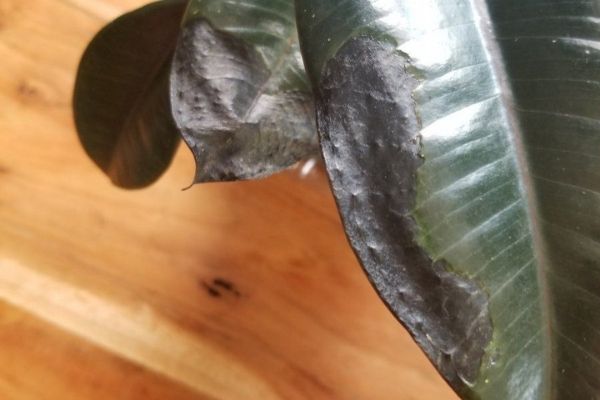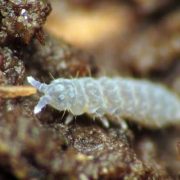
Despite the fact that the rubber plant (or Ficus elastica) is not susceptible to pests or diseases, it can sometimes develop black spots on its leaves.
The most common causes of black spots are fungi, mold, bacteria, and even some viral diseases. Most of them are a direct result of excessive watering. Factors such as low temperatures, excessive humidity, or low light conditions, create a suitable environment for the emergence and development of these pathogenic organisms.
These black spots can make the plant less appealing and in some cases can be bad for the overall health of the plant.
BUT... there is no need for panic! Because in most cases, black spots on the Rubber plant's foliage can be treated fairly easily!
Contents
Causes & treatments of black spots on rubber plant
Various additionally weaken the plant and make it more susceptible to the development of black spots.
There are 7 reasons why your rubber plant is developing black spots on its leaves:
- Overwatering
- Pests
- Old foliage
- Bacterial infections
- Viral infections
- Fungal infection
- Physical damage
Overwatering
The most obvious symptom indicating that you are overwatering your plants is yellow, brown, and sometimes even black spots on the leaves.
However, it does not mean you should rarely water your rubber plant. If the leaves of your rubber plant are turning brown or black, reduce the water intake in the following period.
The general rule with these plants is to let the top 2 inches of the soil dry out between watering.
Additionally, if you are not sure when to water the Rubber plant again, feel the substrate with your fingers, if it is wet skip the watering. In the case that it is dry, water the plant.
Pests
Although Ficus Elastica is a mildly poisonous plant that contains toxic calcium oxalate, this fact does not prevent some of the pests from chewing on the leaves.
The most common pests that do this are aphids and mealybugs. These are tiny insects only ⅛ inch in size that feed on plant sap.
In the process, they secrete a sweet substance known as honeydew. It attracts sooty mold, a fungus that forms spore clumps on the leaf, recognizable as tiny, black dots on the face or back of the leaf.
The extraction of plant juices weakens the plant, disturbs its metabolism, causes the leaves to twist, black spots on the leaves, and on top of all that, the honeydew they leave on the leaf affects the development of fungal diseases.
If you notice pests before they spread throughout the plant, you can try to wash them off under running water.
However, if the infection has already taken hold or your ficus is too large to shower, you can apply one of the standard broad-spectrum insecticides for houseplants' pests control.
If you are a supporter of natural treatments, treat the plant with neem oil (check out my shop) solution that effectively destroys pests.
Old foliage
Each leaf of a plant is an organ that has a function but also a lifespan. No matter how well you take care of the plant, some of its leaves will eventually wither and fall off.
If the foliage is too old, it will die and can develop black spots.
You should remove such leaves regularly before they fall off, accumulate and decompose under the plant on the surface of the substrate.
Rotting is a process that creates additional moisture, releases harmful gases, and can negatively alter and contaminate the composition of the substrate in which the plant grows.
Colonies of fungi, such as Botrytis cinerea, are formed much faster on fallen, dead leaves, from where they spread to healthy plant parts. Additionally, various bacteria and pests will be attracted to such an environment which significantly increases the risk of developing black spots.
Bacterial infections
There is a whole range of bacteria that can attack your plant, but here we will dwell on the most common ones: bacterial Blight and Xanthomonas.
These pathogens most often attack the plant by entering through leaf damages and natural openings or stomas on healthy leaves, causing black spots on the leaves.
The bacterium loves heat, so infections are more common in the summer when the temperature fluctuates between 78 and 86°F.
As soon as you notice signs of infection, remove all infected leaves. If the plant is surrounded by other plants, isolate it to improve air circulation and faster drying of the leaves.
Next two or three weeks, you should not mist the leaves.
Viral infections
The main symptoms of viral infections of the plant are stunted growth and irregular yellow or dark spots on the leaves.
Viruses are usually transmitted by insects such as aphids, but you can also infect the plant with an unsterilized knife or scissors when taking cuttings.
Unfortunately, there is no productive way to fight the virus. The only thing you can try is to cut away the infected parts of the rubber plant, but that is not a guaranty that the black spots will disappear for good.
Fungal infection
In addition to the mentioned fungus Botrytis cinerea and sooty mold, many other fungi can develop on the leaves, causing the appearance of black spots.
Regardless of the species, they all like high humidity, high temperature, and insufficient airflow.
Although fungal infections disturb the overall appearance of the plant more than they endanger its health, fungal infections should be controlled as soon as they appear.
Fortunately, it is not necessary to identify the type of fungus to fight it effectively.
Most of the fungicides you can find on the market are formulated to effectively destroy all major groups of fungi so you can treat sooty mold but powdery mildew with the same agent.
Fungal disease treatment
The first and elementary step in treating fungal infections is to cut off all the affected leaves and isolate the plant. Namely, the fungi reproduce by airborne spores and effortlessly spread to other plants.
After that, treat the plant with a fungicide intended for houseplants (and always read the instructions on the label carefully).
Do not be disappointed if the disease is not stopped with the first application of fungicide because the procedure usually needs to be repeated several times.
Even if the fungus disappears after the first application, still mist your rubber plant at least once more as a preventative measure. In addition, try to eliminate the causes that led to the development of the disease.
Pay close attention to the frequency of watering, do not spray the leaves while the plant is in treatment, and if necessary, you can thin the canopy of your rubber plant to make the air circulate more easily.
Physical damage
The last reason why your rubber plant has developed black spots is because of physical damage.
Cuts on the leaves, broken or cracked shoots can often cause black spots on the leaves. Unfortunately, plants do not have the ability to regenerate such damage.
A cracked leaf will remain cracked until it withers and falls off. Such damage is not only a matter of the plant's appearance but open wounds that expose the plant to infections and diseases.
Therefore, a preventive measure is to cut off every damaged part and always use sterile tools. You can sprinkle the cut with some coal dust, tobacco ash, or treat it with 2% hydrogen to accelerate healing.
How to prevent black spots on a rubber plant
The best way to prevent the black spots is to water your plant according to its needs and provide proper drainage.
An improper mixture or inadequate drainage increases the humidity consequently causing black spots on the leaves. Therefore, a well-draining substrate and a pot with drainage holes are vital.
Maintain airflow in the canopy and prune the plant if necessary if it grows too densely.
Do not place your rubber plant in a cold or too shaded spot. The water evaporates slowly and stays in the substrate and the environment for much longer in such places.
Regularly clean its shiny green leaves with a damp cloth or sponge. By cleaning the leaves you will refresh and moisten the leaves, the plant will look neat, and at the same time, you might remove the potential visible and invisible pests!



